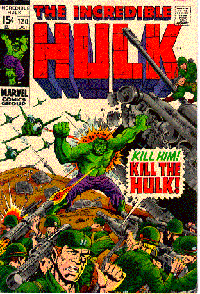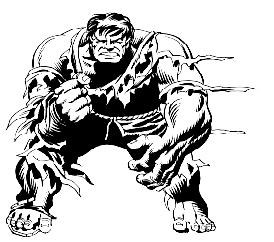I am kicking off my site with a special tribute to the work of the artist whose Hulks were the first I came to know: Herb Trimpe. Growing up in the 1970's, I was exposed to his art not only in the Hulk, but also Marvel's take on Japanese cultural figures, like Shogun Warriors and Godzilla, also drawn by Herb Trimpe. I read the Hulk's comic more than any other because I loved that rough green-skinned brute and Trimpe's artwork (mostly obtained through Marvel Super Heroes reprints).
My first Hulk comic in fact was one drawn by Trimpe--a classic Len Wein story, "The Triumph of the Toad!" (Hulk #191). My copy is nothing but a tattered rag now. However, leafing through it, the images of Hulk's best friends metamophisizing into giant slugs and the Hulk's rage at being tricked into believing this illusion are as vibrant to me now and they were when I was a kid. I like Trimpe's artwork because it is rough and colorful as American art should be. Whether Trimpe is drawing alien slugs, cosmic toad-men, a cigar-smoke-puffing Air Force general, a wave of jets raining down fire, the tear in a heart-broken girl's eye, or a hunted greenskinned man-brute with no friends and no home, the effect is always the same: a terrible sense that something is very wrong. The Hulk might make it right, or, he might leave it even worse. Better off smashed anyway.
Some say that Trimpe's art is what was wrong, but I say the man has style. After Marie Severin's stint with the character from Tales to Astonish and The Incredible Hulk , Trimpe became chief artist of the character for eight years from 1967 to 1975. In the beginning he took Marie's lead and drew a thick, muscled hero with flowing locks of green hair. (This was a take-off Marie's good-looking Green Charles Atlas, a kind of dangerous but sexy hunk Hulk.) Trimpe made the brow ridge heavier--so heavy the Hulk's eyes recessed into his skull. His fat linework essentially gave the Hulk a permanent squint. Thick shading made the Hulk a dense target for both his enemies and the reader. Artillery shells and machine gun fire seemed to gravitate towards this squinting chunky creature with the mean, green grin.
A large element of Trimpe's work on the Hulk (nearly continuous from issue #109 to #193) is the omnipresence of the military. General Thunderbolt Ross' hunt for the Hulk--an echo of Captain Ahab's pursuit of Moby Dick--becomes an important theme in the story when Trimpe became chief artist. This twist on the character surely was Roy Thomas' greatest contribution to the book as a writer; but were it not for Trimpe's tanks and airplanes that side of the Hulk may have not taken root. Compare Jack Kirby's or Steve Ditko's early runs of the Hulk stories in the original six issues or in Tales to Astonish #60-79 and one can appreciate Trimpe's skill at drawing weapons of war.
One of my favorite Trimpe covers is from Hulk #119 where we see soldiers, jets, and tanks all converging on the Hulk. An officer stands in the foreground yelling, "KILL HIM! KILL THE HULK!" Finally it looks like the Army will match the Hulk's violence. I can't believe my mom bought this comic for me.
the Hulk's violence. I can't believe my mom bought this comic for me.
When I learned that Herb Trimpe was coming to Seattle, I flipped my wig. I just had to talk to him. We met at the Seattle Com-Card Convention on November 9, 1997. Herb was very gracious interview subject who tolerates all manner of questioning and pestering. Unlike the Hulk, he is a very tall and thin man who you might mistake for a basketball player--not a comic book artist--and an extremely approachable person.
Herb mentioned how nice of a town Seattle was, and, if it was not for Marie Severin he would not be here. I thought he was making a reference to his tenure on the Hulk, but he explained to me, "She said, 'If you don't go out to the Seattle convention, I won't talk to you anymore.'" Marie Severin led us into a discussion of how he became involved with the Hulk; it was, after all, his first serious assignment at Marvel as an artist. Herb's feelings for Marvel have changed over the years, he freely talked about his career. Although when I first approached Herb Trimpe, Silver Age Artist of The Incredible Hulk, I expected to hear stories about my favorite greenskinned hero. I did, and I learned a lot more.


 the Hulk's violence. I can't believe my mom bought this comic for me.
the Hulk's violence. I can't believe my mom bought this comic for me.